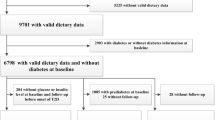Abstract
Objective: To examine longitudinal relationships between nutrition and risk indicators for cardio vascular diseases (CVD) during adolescence and young adulthood. Design: A longitudinal study over fifteen years. Subjects: 98 females and 84 males, from 13 to 27 years. Methods: By means of six interviews dietary patterns were determined. Blood samples were analyzed for serum concentration of total cholesterol (TC), and high-density-lipoprotein (HDL), bloodpressure, body fat and maximal aerobic power (VO2max) were determined. The longitudinal relations were analyzed with generalized estimation equations (GEE), a statistical technique in which relations at different time-points are tested simultaneously. Results: Compared to Dutch recommendations six out of seven macro nutrients appear to be unfavorable with respect to CVD. Borderline or high CVD risk values are apparent at 27 y in more than 25% of the subjects with respect to percentage body fat and serum total cholesterol in both sexes. In males 40% or more show borderline hypertension. The ‘univariate’ longitudinal analyses showed significantly positive relations: (1) between the intake of animal protein, saturated fat (SFA), cholesterol (Chol) and TC, and HDL; (2) between total energy intake (EN) and systolic blood pressure, and VO2max. Significantly negative associations were found: (1) between EN, poly-unsaturated fat (PUFA) and TC concentrations; (2) between EN and sum of four skinfolds (SSF). Conclusions: With increasing age, over a period of 15 y in both sexes the SFA and Chol intake relate significantly to the development of a negative CVD risk profile. The intake of PUFA relates positive to a CVD risk profile. The significantly negative relation between EN intake and body fat (SSF) is partly explained by the relation between EN and VO2max.
Similar content being viewed by others
Author information
Authors and Affiliations
Rights and permissions
About this article
Cite this article
Post, G., Kemper, H., Twisk, J. et al. The association between dietary patterns and cardio vascular disease risk indicators in healthy youngsters: Results covering fifteen years of longitudinal development. Eur J Clin Nutr 51, 387–393 (1997). https://doi.org/10.1038/sj.ejcn.1600419
Received:
Revised:
Accepted:
Issue Date:
DOI: https://doi.org/10.1038/sj.ejcn.1600419
- Springer Nature Limited
Keywords
This article is cited by
-
Change in diet in the period from adolescence to early adulthood: a systematic scoping review of longitudinal studies
International Journal of Behavioral Nutrition and Physical Activity (2017)
-
Modifiable Environmental and Behavioral Determinants of Overweight among Children and Adolescents: Report of a Workshop*
Obesity (2006)
-
A 12-year follow-up study of treated obese children in Japan
International Journal of Obesity (2002)
-
Relationships between the development of biological risk factors for coronary heart disease and lifestyle parameters during adolescence
Public Health (1999)




